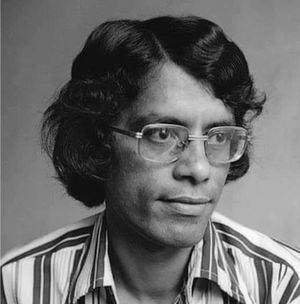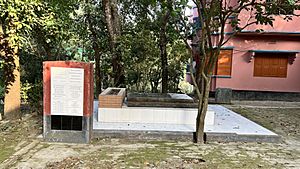Humayun Azad facts for kids
Quick facts for kids
Humayun Azad
|
|
|---|---|
 |
|
| Native name |
হুমায়ুন আজাদ
|
| Born | Humayun Kabir 28 April 1947 Bikrampur, Bengal Presidency, British India (now in Munshiganj District, Bangladesh) |
| Died | 12 August 2004 (aged 57) Munich, Germany |
| Resting place | Munshiganj |
| Occupation | poet, novelist, linguist, critic, columnist, professor |
| Language | Bengali, English |
| Nationality | Bangladeshi |
| Education | PhD (linguistics) |
| Alma mater | University of Dhaka (BA, MA) University of Edinburgh (PhD) |
| Notable works | Laal Neel Deepabali Chhappanno Hajar Borgomail |
| Notable awards | Bangla Academy Literary Award Ekushey Padak |
| Spouse |
Latifa Kohinoor
(m. 1975) |
Humayun Azad (born Humayun Kabir; 28 April 1947 – 12 August 2004) was a famous writer from Bangladesh. He was a poet, novelist, and professor at Dhaka University. He also studied languages and wrote about books and society.
Humayun Azad wrote over sixty books. He received the Bangla Academy Literary Award in 1986. This award was for his important work in Bengali language studies. In 2012, the Government of Bangladesh gave him the Ekushey Padak. This special award was given after his death for his contributions to Bengali literature.
Contents
Early Life and School
Humayun Azad was born on 28 April 1947. His birth name was Humayun Kabir. He was born in Rarhikhal village in Bikrampur. This village is now part of Munshiganj District. A famous scientist, Jagadish Chandra Bose, was also born in this same village.
Azad finished his secondary school in 1962. He then completed higher secondary school in 1964 from Dhaka College. He earned his BA and MA degrees from the University of Dhaka. He studied Bengali language and literature there. Later, he got his PhD in linguistics from the University of Edinburgh in 1976. His PhD paper was about how pronouns work in the Bengali language. On 28 September 1988, he officially changed his last name from Kabir to Azad.
His Career as a Professor
Azad began his career in 1969 at Chittagong College. He became a lecturer at the University of Chittagong in 1970. In 1972, he joined Jahangirnagar University.
He moved to the University of Dhaka in 1978 as an associate professor. He taught Bengali there. In 1986, he became a full professor.
His Books and Writings
Humayun Azad's first book was a collection of poems. It was called Alaukik Istimar (meaning "Unearthly Steamer"). This book came out in 1973. That same year, he went to Scotland to study for his PhD.
In 1979, he wrote a short story called Onoboroto Tusharpat (meaning "Heavy Snowing"). This story was inspired by his life with his wife, Latifa Kohinoor. He later included this story in his 1996 book, Jadukorer Mrityu (meaning "Death of the Magician").
In the late 1980s, Azad started writing newspaper articles. These articles focused on current social and political topics. He continued writing these through the 1990s and early 2000s. Many of these articles were later published as books. During this time, he also became known as a novelist.
Naree and Its Impact
In 1992, Azad published Naree (meaning "Woman"). This was the first major book in Bengali about women's rights. The book discussed how society treated women. It talked about how men often had more power.
Naree received both good and bad reviews. It was seen as a very important book for women's rights in Bangladesh. In the book, Azad praised some British Indian reformers. But he also criticized famous Bengali writers like Rabindranath Tagore. Many readers in Bangladesh did not like his strong views. The Government of Bangladesh banned the book in 1995. However, Azad fought the ban in court and won. The ban was lifted in 2000.
His Novels for Adults
In 1994, he published his first novel, Chhappanno Hajar Borgomail. This title means "Fifty-six thousand square-miles," which is the area of Bangladesh. The novel was about military rule in Bangladesh during the 1980s.
His second novel, Sab Kichu Bhene Pare (1995), was also very popular. It explored relationships in Bangladeshi society. His last novel, Ekti Khuner Svapna (meaning "Dreaming of a Murder"), was published in 2004. This book was about unrequited love. The main character lived in a student hall at Dhaka University, just like Azad did when he was a student.
Books for Young Readers
Humayun Azad also wrote books for teenagers. One of his well-known books for young people is Laal Neel Deepabali. He wrote this book to teach Bangladeshi teenagers about the history of Bengali literature in a simple way.
Attack on His Life
On 27 February 2004, Humayun Azad was attacked. This happened near the University of Dhaka campus during a book fair. Two attackers used machetes to hurt him. He was hit on his jaw, neck, and hands.
He was taken to the hospital. The Prime Minister of Bangladesh at the time, Khaleda Zia, ordered him to be moved to a special hospital for better care. He was later sent to a hospital in Thailand, where he got better.
Azad had been worried about his safety. This was after parts of his novel, Pak Sar Jamin Sad Bad (meaning "Be Blessed the Sacred Land"), were published in 2003. In this novel, he strongly criticized certain political ideas. After the book came out, he started getting threats.
A week before the attack, a member of parliament, Delwar Hossain Sayeedi, spoke about Azad's book. He said the book should be banned. In 2006, a leader of a group called Jamaat-ul-Mujahideen Bangladesh (JMB) admitted that his group attacked Azad.
His Death
On 12 August 2004, Humayun Azad was found dead in his apartment in Munich, Germany. He had gone there to do research on a German poet. This was several months after the machete attack.
His family asked for an investigation. They believed that the people who attacked him earlier might have been involved in his death. Humayun Azad had wanted to donate his body for medical research after he died. However, he was buried in his home village in Bangladesh. This was because doctors could not accept his body for research after several days had passed.
His Family Life
Humayun Azad married Latifa Kohinoor on 12 October 1975. He first met her in 1968 when they were both students at Dhaka University. They had two daughters, Smita and Mouli, and one son, Anannya.
See also
 In Spanish: Humayun Azad para niños
In Spanish: Humayun Azad para niños


